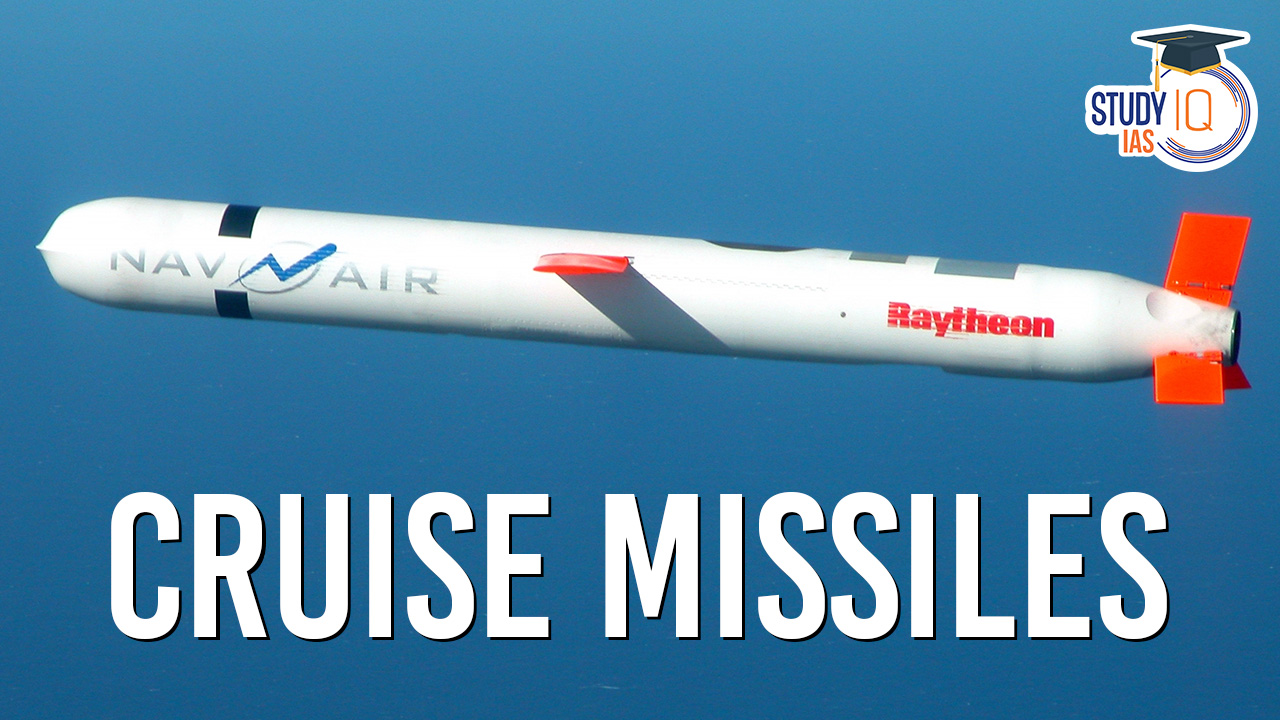Table of Contents
A cruise missile is a precision-guided, unmanned aircraft designed for long-range, low-altitude flight. It’s equipped with advanced navigation systems and often a payload, like explosives. Cruise missiles are used by militaries for targeted strikes on enemy targets, such as infrastructure or military installations. They can be launched from various platforms, including ships, submarines, aircraft, and ground-based launchers, and their ability to fly at low altitudes and use terrain-following technology makes them challenging to detect and intercept, adding to their effectiveness in modern warfare.
Cruise Missiles
A cruise missile is a precision-guided missile utilized for targeting both land-based and naval objectives. These missiles are engineered to accurately transport substantial warheads across significant distances. Cruise missiles are unmanned, jet engine-propelled vehicles that can be deployed from ground, air, or sea-based platforms. Notably, they operate within the Earth’s atmosphere throughout their flight and are capable of flying at altitudes as low as a few meters above the ground.
We’re now on WhatsApp. Click to Join
Cruise Missiles Characteristics
Cruise missiles exhibit specific characteristics:
- They maintain consistent speed and altitude within Earth’s atmosphere.
- With an 8.5-foot (2.61-meter) wingspan, they possess a compact design.
- Turbofan engines power their propulsion.
- Depending on the configuration, they cover distances ranging from 500 to 1,000 miles (805 to 1,610 km).
- They can be equipped with either nuclear or conventional warheads.
- Self-guided, they employ diverse methods for precise payload delivery, including terrain mapping, GPS, and inertial guidance through motion sensors and gyroscopes to adhere to preset flight paths.
Initially developed for long-range nuclear payload delivery, these missiles were engineered with minimal radar visibility and a preference for low-altitude, slow-speed flight near the Earth’s surface.
Examples of Cruise Missile
| Cruise Missile | Country | Key Features |
| Tomahawk | United States | Subsonic, versatile, used by Navy and Air Force |
| BrahMos | India/Russia | Supersonic, multi-platform, precision |
| Storm Shadow/SCALP | France/UK | Long-range air-launched, precision strikes |
| AGM-86 ALCM | United States | Subsonic, carried by strategic bombers |
| Kh-101/102 | Russia | Subsonic, conventionally and nuclear armed |
| Hyunmoo-3 | South Korea | Land-attack and anti-ship variants |
Cruise Missiles vs Ballistic Missiles
| Aspect | Cruise Missiles | Ballistic Missiles |
| Trajectory | Low-altitude, level flight within the atmosphere | High-altitude, parabolic trajectory into space |
| Speed | Subsonic to supersonic | Subsonic to hypersonic (much faster) |
| Steering | Can alter course during flight (maneuverable) | Limited in-flight guidance, less maneuverable |
| Altitude | Flies at low to medium altitudes | Soars into space, re-enters the atmosphere |
| Range | Typically shorter range (100-1,000 miles) | Longer range (hundreds to thousands of miles) |
| Precision | Highly accurate, can engage specific targets | Less precise, typically used for area targets |
| Warhead Types | Can carry both conventional and nuclear warheads | Often designed for nuclear warheads |
| Launch Platforms | Various platforms (ships, submarines, aircraft) | Typically launched from fixed or mobile sites |
| Advantages | Versatile, can evade enemy defenses, precise | High-speed, difficult to intercept, extended range |
| Disadvantages | Limited range compared to ballistic missiles | Less precision, less flexibility in targeting |
| Examples | Tomahawk, BrahMos, Storm Shadow | ICBMs, IRBMs, SCUD, Minuteman III |
Cruise Missiles in Indian
India has developed and deployed several cruise missiles for its defense and strategic purposes. Some notable Indian cruise missiles include:
| Cruise Missile | Key Features and Details |
| BrahMos | Supersonic, versatile, can be launched from land, sea, and air platforms; anti-ship and land-attack capabilities |
| Nirbhay | Subsonic, long-range, indigenously developed, land-attack cruise missile capable of carrying conventional and nuclear warheads |
| BrahMos-NG | A lighter and more versatile version of BrahMos, designed for a wider range of launch platforms, including fighter aircraft |
| NAG (Helina) | Anti-tank guided missile (ATGM) developed for use with Indian Army helicopters, designed for precision strikes against armored targets |
| SANT | Stand-Off Anti-Tank (SANT) missile, an anti-tank guided missile designed for various launch platforms, including aircraft and ground-based systems |
BrahMos
The BrahMos cruise missile is the result of a collaborative effort between India’s DRDO (Defence Research and Development Organisation) and Russia’s NPO Mashinostroyeniya. Its name is a fusion of the Brahmaputra and Moskva rivers.
In a significant milestone on June 12, 2001, the BrahMos supersonic cruise missile was successfully test-fired from a land-based launcher in Chandipur. Over the past two decades, it has undergone multiple upgrades and versions for deployment on land, air, and sea platforms.
The development of BrahMos can be traced back to India’s Integrated Guided Missile Development Programme, which commenced in the early 1980s under the leadership of Dr. A.P.J. Abdul Kalam. This program led to the creation of a family of missiles, including Prithvi, Agni, Trishul, Akash, and Nag.
In 1998, India and Russia signed an Inter-Governmental Agreement in Moscow, leading to the establishment of BrahMos Aerospace. This joint venture comprises a 50.5% stake held by the Indian side and 49.5% by the Russians. Subsequently, in 1999, work on missile development began in laboratories of DRDO and NPOM (NPO Mashinostroyeniya) following the allocation of funds by the two governments.
Strategic Significance
BrahMos is a two-stage missile featuring a solid propellant booster engine that propels it to supersonic speed. The first stage then separates, allowing the liquid ramjet in the second stage to accelerate the missile to nearly three times the speed of sound during the cruise phase.
The missile boasts a low radar signature, making it difficult to detect and is highly maneuverable with the ability to follow various trajectories. Its ‘fire and forget’ nature enables it to achieve cruising altitudes of up to 15 km, with terminal altitudes as low as 10 meters to effectively strike the target.
BrahMos falls into the category of “standoff range weapons,” which means it can be fired from a distance sufficient to evade counter-fire. In terms of performance, it surpasses subsonic cruise missiles with triple the speed, 2.5 times the range, and an extended reach.
Versions Across Armed Forces
BrahMos has seen deployment in all three branches of India’s armed forces and continues to undergo regular testing and enhancements.
- Land-Based: The land-based BrahMos systems consist of mobile autonomous launchers, each carrying multiple missiles. These batteries have been deployed along India’s land borders, with upgraded versions offering even greater range and speed.
- Ship-Based: The Indian Navy integrated BrahMos onto its frontline warships starting in 2005, granting them the ability to target sea-based threats beyond the radar horizon. These naval versions are capable of launching in single or multiple salvo modes.
- Air-Launched: BrahMos-equipped Sukhoi-30MKI aircraft, with an impressive range, are vital for strategic deterrence. They can be used along land borders and in the Indian Ocean Region.
- Submarine-Launched: This variant is designed for launch from submarines, even when submerged, with specialized settings for underwater and above-water flight.
Cruise Missiles UPSC
The BrahMos cruise missile, a joint venture between India’s DRDO and Russia’s NPO Mashinostroyeniya, is renowned for its precision and versatility. Named after the Brahmaputra and Moskva rivers, it is capable of supersonic speeds and features a two-stage design. The missile offers both anti-ship and land-attack capabilities and can be launched from land, sea, air, and submarines. BrahMos is distinguished by its low radar signature, advanced maneuverability, and a range of up to 500 km. It has been integrated across India’s armed forces, providing strategic deterrence and enhancing national defense capabilities on land, at sea, and in the air.


 AI and its Regulation in India, Limitati...
AI and its Regulation in India, Limitati...
 Tuberculosis (TB), Symptoms, Causes and ...
Tuberculosis (TB), Symptoms, Causes and ...
 Silicon Photonics Enables Low-power AI A...
Silicon Photonics Enables Low-power AI A...





















